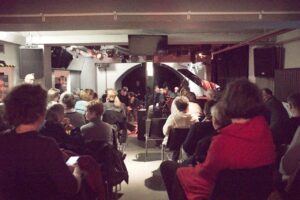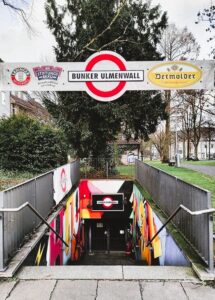#1303 地下壕から放つ 響き: 小橋敦子&トニー・オーヴァーウォーター
ブンカ―・ウルマーヴァル Bunker Ulmenwall, Germany
地下壕から放つ 響き:
ブンカ―・ウルマーヴァル Bunker Ulmenwall, Germany
text by Atzko Kohashi 小橋敦子
photos courtesy of Bunker Ulmenwall, and Tony Overwater
https://bunker-ulmenwall.org/


Bunker Ulmenwall 地下壕への階段 地下内部でのコンサート
アムステルダムから東に向かって300㎞、車で4時間ほど走るとドイツ北西部の街ビーレフェルト Bielefeldに到着する。この街のブンカー・ウルマーヴァル Bunker Ulmenwall というライヴ・ハウスで演奏するため、デュオの相方のトニー・オーバーウォーター(bass)と出かけたのは、まだまだ春の遠い去る2月のこと。車から降りると、すぐ近くにシュパレンブルグ城 Sparrenberg の塔が見える。坂の向こうには、ドイツ独特のあの尖った屋根の教会も。オランダからドイツに来て嬉しいのは、緩やかな傾斜とはいえ坂道から見下ろしたり、見上げたり、景色の見え方が違うこと。遥か向こうに丘が見えるなんて、まっ平らな国オランダではほとんどあり得ない。ふと通りの反対側に目をやると、私たちが大写しになった今夜のコンサートのポスターが目に飛び込んできた。「会場はこのすぐ近くのはずよね?」と辺りを見まわすが、それらしき外観はどこにもなく、Bunker Ulmenwallと書かれた地下の入口に向かう階段だけが、ぱっくりと口を開けたように見える。なんだか怪しげな場所…と思いながら階段を下りていくと、内部は狭い通路と通路が交差していて、まるで迷路のようだ。案内された楽屋も細長く、その奥にはさらに部屋が続いて・・・という具合。実はこの場所は第二次大戦中の地下壕(=bunker)で、戦時中は医療施設として使われていたそうだ。地下のひんやりとした冷気を肌に感じながら、激しい爆撃の中で治療を急ぐ人々がこの階段を駆け降りてくる、そんな光景が一瞬頭をよぎった。


ステージを囲む観客席 (2月24日のコンサートで)
20平米ほどの小さなステージには黒光りする大きなピアノが据えられている。そのステージの両側と正面の三方向からミュージシャンを囲むようにして観客席がある。空間には、ステージを遮るように鏡張りの柱が所どころに並んでいる。そこに映し出される人々、そしてステージの私たちの姿とが幾重にも重なって、鏡の効果は面白い。ステージと一体となった客席とはこのことだろう。決して広くはない会場が、この夜は80人〜90人ほどの人たちで埋め尽くされた。ドイツ人のオーディエンスはとても真摯でフレンドリー、そのうえ、スタッフも優しく温かい人ばかりだ。ドイツと日本、大戦中の同盟の絆のせいかしら?と思っていたが、よく話を聞いてみると、「山下洋輔もここで演奏したことがある。藤井郷子、田村夏樹も。高瀬アキは Alexander von Schlippenbach と一緒によくここで演奏する…」と、続々と日本人ミュージシャンたちの名前があがる。日本人の私にフレンドリーなのにはこんな理由があったのでしょう。そんなわけで、この夜は「日本人女性がジャズ?どうして?」というような質問を受けることもなく、温かい拍手の中で3回もアンコールをするという幸せな夜になった。高瀬さんや藤井さんに感謝!
コンサートでは、私たちのアルバム『クレッセント』からの曲を中心に演奏したのだが、コルトレーンの曲想がしっとりとこの地下の壁に染み込んでいくように感じた。地下壕での特別な響きのせいなのか、始終息をひそめ静かに聞き入る観客のせいなのか、戦時中のここでの出来事を想像してなのか・・・?このBunker Ulmenwall に宿る不思議なエネルギーのせいかもしれない。構成も調性もはっきりとしている私たちの音楽は決してフリージャズとは言い難いが、この空間に漂う「解き放たれるような感覚」が私たちの演奏をより自由なものにしたことは確かだろう。

コンサートでTony Overrwaterと 鏡の柱のリフレクション
このブンカ―・ウルマーヴァル Bunker Ulmenwall の地下壕は、1939/40年頃にナチスの攻撃戦争の準備の一環として既に建設されていたが、戦時中には空襲で負傷した人々の治療の場となった。戦後は小さな製薬会社がここでエーテル製品を製造したり、1947年以降はナチ統治の終焉後に再編成された青年団体の避難所にもなっていたという。その後、まだ設備も何もないこの地下壕を文化的に利用しようとパペット劇団が活動を始めた。1956年頃になると、ようやくここでジャズが聞かれるようになった。当時は地元のバンドが奏でるデキシーランドやオールドタイム・ジャズが主流だったそうだ。戦後のビッグバンド・ジャズブームで、この街にもスタン・ケントンオーケストラがやって来て熱狂的な演奏を繰り広げていた。その中のメンバーの一人が若き日のリー・コニッツ。その後40年余り経ち、彼はビーレフェルトを度々訪れては、ブンカ―・ウルマーヴァルのこの小さなステージで演奏していったそうだ。
戦後の紆余曲折を経て、文化施設として利用されるようになったブンカ―・ウルマーヴァルは、ミュージシャンの演奏の場としてだけでなく、音楽、アートについて語る場、議論の場として親しまれるようになる。小劇場/キャバレー、シャンソン、文学、朗読会、室内劇場、映画、ディスカッション、パペットシアター(人形劇)などのイヴェントも定期的に行われ、60年代には、特にジャズと文学において、「メインストリームから外れた文化の中心地」としてその名を知られるようになった。その当時、国内外から作家を招いて催されていた朗読会や講演会は、ドイツ国内で大きな反響を呼んだそうだ。一方で、新しいジャズのムーヴメントだったフリー・ジャズ、フリー・インプロヴィゼーションに理解を示し積極的に取り入れていたブンカ―・ウルマーヴァルには、演奏の場を探し求めてあちこちから多くのミュージシャンが集まってきたという。

人形劇に集ま る人たち(1950年代頃). 今のブンカ―・ウルメンワール
その意志を引き継ぎながら、今もこの地下壕ブンカ―・ウルマーヴァルは新しいアイデアの実験室であり、商業ビジネスでは無視されがちなものの舞台として、ビーレフェルトの街に存続しつづけている。「市民にとって必要な場所だ」と多くの人々の支持を得て、このブンカ―・ウルマーヴァルは2014年にドイツ最高の会場(カテゴリー2)として表彰されたそうだ。
この夜、コンサートが終了したのはすでに夜11:00近くだったろうか。人々が去って静まり返った地下壕の中で、ブンカ―・ウルマーヴァルの生き証人だという人と話す機会を得た。大戦中ドイツはナチスによってジャズは退廃音楽ということで禁じられ、日本では敵国の音楽であったジャズは当然のように禁止され、そしてどちらも敗戦。戦後の負の遺産は大きく、国民は貧しい中でアイデンティティーを失い・・・そんな中で解放と自由の音楽であるジャズに人々は惹かれ、大いに勇気づけられたのだ、と。ドイツと日本、音楽を通じての絆は今も強い。


Bunker Ulmenhall 入り口で
♪ 関連記事
https://jazztokyo.org/reviews/cd-dvd-review/post-67619/
https://jazztokyo.org/interviews/post-74516/
English Transration
“The Sound Emitted from the Underground” – Bunker Ulmenwall, Germany
Traveling approximately 300 kilometers east from Amsterdam, about a four-hour drive, we arrived in the northwestern German city of Bielefeld. It was still far from spring in February when I went out with my duo partner Tony Overwater (bass) to play at Bunker Ulmenwall, a live house in this city. Stepping out of the car, I saw the tower of Sparenberg Castle nearby. On the other side of the hill, there is a church with a pointed roof, typical of Deutschland. What makes me happy to come to Germany from the Netherlands is the different way of looking down and up from the hill, even though it is a gentle slope. It is almost impossible in the Netherlands, a flat country, to see a hill in the far distance. Looking across the street, I noticed a poster for tonight’s concert with a big picture of us on it. Isn’t the venue supposed to be right around the corner? I looked around, but there was nothing in sight. Only the staircase leading to the underground entrance with “Bunker Ulmenwall” written on it stood wide open, like a gaping mouth. It seemed like a shady place… descending the stairs, we found ourselves in a narrow passage intersecting with others, resembling a maze. The dressing room we were directed to was also long and narrow, with more rooms extending further back… and so on. It turns out this place was a bunker during World War II, used as a medical facility at the time. Feeling the coolness of the underground air on my skin, for a moment, I imagined people rushing down these stairs amidst fierce bombings, desperate for treatment.
A large black piano was set on a stage of about 20 square meters. Surrounding the stage from both sides and the front were seats for the audience, creating an enclosed space. Mirrored pillars were placed here and there, reflecting the people and our figures on stage, creating an intriguing effect. It feels like the audience and the stage were integrated into one. Though not spacious, the venue was filled with about 80 to 90 people that night. The German audience was sincere and friendly, and the staff were all kind and warm. I wondered if it was because of the alliance between Germany and Japan during the war? But as I listened closely, names of Japanese musicians kept coming up: “Yosuke Yamashita has performed here. Satoko Fujii and Natsuki Tamura too. Aki Takase often plays here with Alexander Schlippenbach.” Perhaps that’s why they were so friendly to me, a Japanese. So, that night, I didn’t receive any questions like “A Japanese woman playing jazz? Why?” and it turned into a happy night with warm applause and three encores. Thank you, Takase-san and Fujii-san!
During the concert we mainly played songs from our album “Crescent,” and I felt Coltrane’s spirit seeping into the walls of this underground venue. Whether it was because of the special acoustics of the bunker, the audience’s attentive silence throughout, or imagining the events that took place here during wartime… or perhaps it was the mysterious energy residing in Bunker Ulmenwall. Although our music, with its clear structure and tonality, cannot be labeled as free jazz, the sense of liberation pervading this space made our performance feel even freer.
The underground bunker here was already built around 1939/40 as part of the preparations for the Nazi offensive war, but during the war it became a place to treat people injured in air raids. After the war, a small pharmaceutical company manufactured ether products here, and from 1947 onwards, it served as a shelter for youth groups reorganized after the end of Nazi rule. Later, puppet theater groups began using this underground space, aiming to use here culturally. Around 1956, jazz could finally be heard at this bunker. At that time, local bands mainly played Dixieland and old-time jazz. With the post-war big band jazz boom, the Stan Kenton Orchestra also came to this city, delivering enthusiastic performances. One of its members was a young Lee Konitz. Over the next forty years or so, he visited Bielefeld several times, performing on this stage at Bunker Ulmenwall.
After various twists and turns following the war, Bunker Ulmenwall, now used as a cultural facility, became not only a venue for musicians but also a place cherished for discussions about music and art. Events such as small theater/cabaret performances, chansons, literature readings, recitals, indoor theaters, movies, discussions, and puppet theater performances were held regularly. In the 1960s, it became known as a “cultural center out of the mainstream,” especially in jazz and literature. At that time, reading and lecture events featuring invited writers from home and abroad garnered significant attention within Germany. On the other hand, Bunker Ulmenwall, which actively embraced the new jazz movement of free jazz and free improvisation, attracted many musicians from all over in search of performance opportunities.
Continuing that legacy, even now, Bunker Ulmenwall remains an experimental laboratory for new ideas and a stage for things often ignored by commercial ventures, continuing to thrive in the city of Bielefeld. It received recognition as Germany’s top venue (Category 2) in 2014, supported by many who consider it a necessary space for the community.
The concert ended that night, already close to 11:00 PM. In the quiet underground bunker after everyone left, I had the opportunity to speak with someone who was a living witness of Bunker Ulmenwall. During the war, jazz was banned in Germany as decadent art by the Nazis, and in Japan, jazz, as music of the enemy country, was of course prohibited. Both countries faced defeat in the war.The negative legacy of the post-war period was significant, and people lost their identities in poverty. In such times, people were drawn to jazz, the music of liberation and freedom, and greatly encouraged. The bond between Germany and Japan through music remains strong even today.

